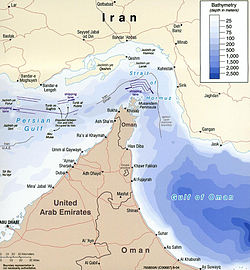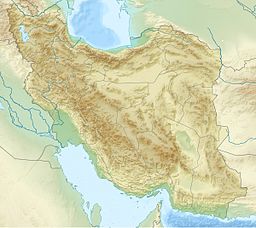
Back Straat van Hormuz Afrikaans مضيق هرمز Arabic Estrechu d'Ormuz AST Hörmüz boğazı Azerbaijani Һормуз боғаҙы Bashkir Армузскі праліў Byelorussian Армуская пратока BE-X-OLD Ормузки проток Bulgarian হরমুজ প্রণালি Bengali/Bangla Strizh-mor Hormuz Breton
| Strait of Hormuz | |
|---|---|
 Satellite image | |
| Location | Persian Gulf–Gulf of Oman |
| Coordinates | 26°36′N 56°30′E / 26.6°N 56.5°E |
| Type | Strait |
| Basin countries | Oman, Iran, United Arab Emirates |
| Min. width | 21 nmi (39 km) |
| Islands | Hormuz Island Qeshm Island |
| Settlements | List |



The Strait of Hormuz (/hɔːrˈmuːz/ Persian: تنگهٔ هُرمُز Tangeh-ye Hormoz ⓘ, Arabic: مَضيق هُرمُز Maḍīq Hurmuz) is a strait between the Persian Gulf and the Gulf of Oman. It provides the only sea passage from the Persian Gulf to the open ocean and is one of the world's most strategically important choke points.[1] On the north coast lies Iran, and on the south coast lies the Musandam peninsula, shared by the United Arab Emirates and the Musandam Governorate, an exclave of Oman. The strait is about 90 nautical miles (167 km) long, with a width varying from about 52 nmi (96 km) to 21 nmi (39 km).[2][3]
A third of the world's liquefied natural gas and almost 25% of total global oil consumption passes through the strait, making it a highly important strategic location for international trade.[3][4] It has been so for centuries; its vast hinterlands were rich in luxury trade goods with no easy access to lucrative trading ports. Babur's memoirs recount how almonds had to be carried from the distant Ferghana region to Hormuz to reach markets.[5]
- ^ Viktor Katona. "How Iran Plans To Bypass The World's Main Oil Chokepoint". Oilprice.com. Archived from the original on 11 September 2018. Retrieved 11 September 2018.
- ^ Jon M. Van Dyke (2 October 2008). "Transit Passage Through International Straits" (PDF). The Future of Ocean Regime-Building. University of Hawaii. p. 216. doi:10.1163/ej.9789004172678.i-786.50. ISBN 9789004172678. Archived from the original (PDF) on 7 August 2020. Retrieved 6 July 2019.
- ^ a b "The Strait of Hormuz is the world's most important oil transit chokepoint". U.S. Energy Information Administration. 4 January 2012. Archived from the original on 11 September 2018. Retrieved 11 September 2018.
- ^ "2 oil tankers were damaged in possible attacks in the Gulf of Oman". Vox. 13 June 2019. Archived from the original on 21 February 2020. Retrieved 13 June 2019.
- ^ History of Civilzations of Central Asia Volume V: Development in contrast from the 16th century to the mid 19th century. UNESCO. p. 335.
© MMXXIII Rich X Search. We shall prevail. All rights reserved. Rich X Search
